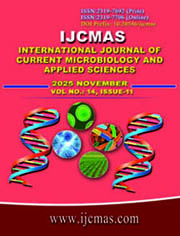


 National Academy of Agricultural Sciences (NAAS)
National Academy of Agricultural Sciences (NAAS)

|
PRINT ISSN : 2319-7692
Online ISSN : 2319-7706 Issues : 12 per year Publisher : Excellent Publishers Email : editorijcmas@gmail.com / submit@ijcmas.com Editor-in-chief: Dr.M.Prakash Index Copernicus ICV 2018: 95.39 NAAS RATING 2020: 5.38 |
The objective of this study was to investigate the degree of genotypic variation and their interaction across multiple environments to select rice (Oryza sativa L.) genotypes with superior grain yield and quality and to find out the interaction of genotypes with different environments with respect to grain yield and quality traits. Given that rice constitutes (>50% of the world's population food staple and Asia especially) a significant portion of the world's food supply, there is a great demand to produce high-yield, high-quality varieties. Nevertheless, the success of many breeding programs is impaired by the lack of performance stability contributed by genotype-environment interactions (G×E). Twenty (20) sdiverse rice genotypes were grown under three diverse agro-climatic regions in two consecutive kharif seasons for the present investigation. Agronomic (days to flowering and plant height) and quality (grain yield, head rice recovery, length-breadth ratio, amylose content and cooking time) traits were evaluated. Experimental design was Randomized Complete Block Design (RCBD) with three replications at each location. Multivariate statistical analysis such as Mahalanobis D², Principal Component Analysis (PCA) and AMMI and GGE biplot models were used for data analysis. The experiment indicated a high genotypic divergence for yield and quality components. On the other hand, genotypes NDRK 5094 and PUSA834 were stable and superior for their performance across the environments indicating wide adaptation. The AMMI and GGE analyses also indicated specific genotypes specialized to particular environments and those with wider adaptation. The genotypes were classified into various clusters that would be beneficial in choosing diverse parents for future breeding purposes. Such findings could be used not only by breeders to select favorable genotypes for targeted breeding programs, but also by agronomists and policy makers as reference information for the selection of region specific rice varieties that meet the productivity as well as consumer preference values.
Bisne, R., Sarawgi, A. K., & Verulkar, S. B. (2009). Genetic analysis of quantitative traits in rice (Oryza sativa L.) under irrigated and rainfed conditions. Indian Journal of Agricultural Sciences, 79(1), 46–50.
Das, P. K., & Mandal, N. (2020). Genetic divergence analysis for yield and quality traits in rice (Oryza sativa L.). International Journal of Current Microbiology and Applied Sciences, 9(7), 1525–1534. https://doi.org/10.20546/ijcmas.2020.907.177
Fitzgerald, M. A., McCouch, S. R., & Hall, R. D. (2009). Not just a grain of rice: The quest for quality. Trends in Plant Science, 14(3), 133–139. https://doi.org/10.1016/j.tplants.2008.12.004
Juliano, B. O. (1993). Rice in human nutrition. Food and Agriculture Organization of the United Nations (FAO). https://www.fao.org/3/t0567e/t0567e.pdf
Kumar, S., Singh, C. M., & Singh, A. K. (2015). Genetic variability, heritability and genetic advance in early generations of rice under rainfed lowland. Bangladesh Journal of Agricultural Research, 40(2), 193–202. https://doi.org/10.3329/bjar.v40i2.23199
Mahalingam, R., & Geethanjali, S. (2021). AMMI and GGE biplot analysis for stability in rice genotypes. Electronic Journal of Plant Breeding, 12(3), 829–836. https://doi.org/10.37992/2021.1203.107
Patel, J. R., Patel, M. B., & Patel, K. M. (2019). Genetic divergence in rice (Oryza sativa L.) for yield and quality traits. International Journal of Chemical Studies, 7(2), 361–364.
Rao, C. R. (1952). Advanced statistical methods in biometric research. John Wiley & Sons.
Singh, P., & Yadav, R. K. (2020). Evaluation of rice genotypes for yield and quality traits under different environments. Journal of Pharmacognosy and Phytochemistry, 9(2), 1860–1864.
Singh, R. K., & Chaudhary, B. D. (1985). Biometrical methods in quantitative genetic analysis. Kalyani Publishers.
 |
 |
 |
 |
 |